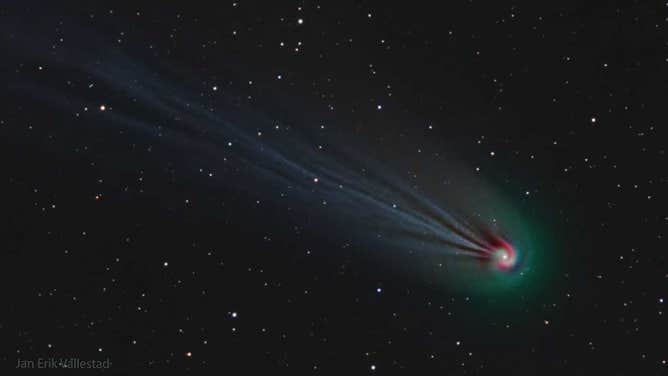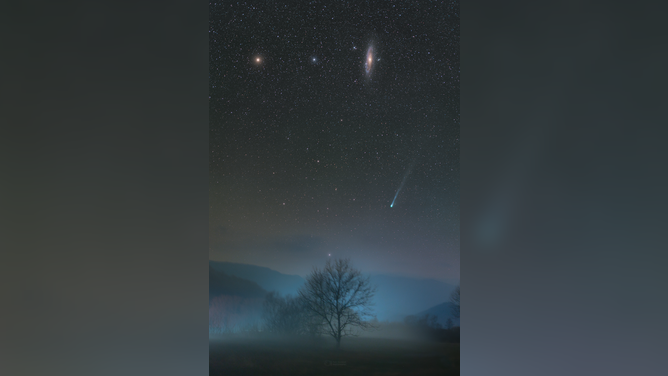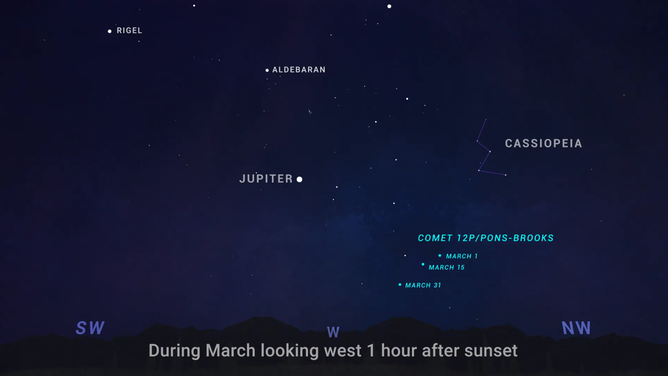'Devil' Comet 12P puts on colorful spiral display as it approaches Sun ahead of total solar eclipse
Comet 12P is expected to be nearest the Sun in its 71-year orbit around the April 8 total solar eclipse, which will be visible in parts of Mexico, the U.S. and Canada.
'Devil' Comet 12p approaches Sun in time for total solar eclipse
Comet 12P/Pons-Brooks also known as the "devil comet" is zooming toward its closest approach to the Sun, known as perihelion. Astronomers are tracking the comet in the night sky and its colorful reactions.
A comet approaching the Sun in time for April's North American total solar eclipse is putting on a spectacular show in the sky.
According to NASA, Comet 12P/Pons-Brooks is zooming toward its closest approach to the Sun, known as perihelion. The comet is expected to be nearest the Sun in its 71-year orbit about the same time as the April 8 total solar eclipse, which will be visible in parts of Mexico, the U.S. and Canada.
WHAT YOU NEED TO KNOW ABOUT APRIL'S TOTAL SOLAR ECLIPSE
Comets are frozen leftovers from the formation of our solar system about 4.6 billion years ago, made up of dust, rocks and ice. As comets approach the Sun, they heat up and create a glowing atmosphere, or coma, and form the famous bright comet's tail, that can stretch for millions of miles, according to NASA.
Comet 12P is a Halley-type comet discovered by Jean Louis Pons in Marseilles, France, in 1812, according to NASA's small body database. Last year, as 12P began to heat up and its eruptive behavior began increasing, the comet earned the nickname the "Devil Comet" because of its hornlike appearance. The devilish horns have faded away in recent months.
Photographers have been capturing 12P’s greenish glowing tail and even a spiral in recent weeks, putting on a colorful display.
Norwegian Astrophotographer Jan Erik Vallestad has been documenting the changes in Comet 12P as it approaches perihelion. Last week, he created a composite image of different exposures to show the evolution of the comet’s ion tail in blue and the outer coma in green. The image below shows the glowing gases around the coma in a spiral.

The featured image is a composite of three very specific colors, showing the comet's ever-changing ion tail in light blue, its outer coma in green, and highlights some red-glowing gas around the coma in a spiral. The spiral is thought to be caused by gas being expelled by the slowly rotating nucleus of the giant iceberg comet. (Image Credit & Copyright: Jan Erik Vallestad )
(Jan Erik Vallestad)
Earlier this month, Petr Hralek, with the Institute of Physics in Opava, recorded the comet's bright blue tail above a foggy scene in Revuca, Solvakia. Also seen in the original image are the Andromeda Galaxy and the bright yellow star Mirach.

Seen despite a foggy atmosphere, Comet 12P's green coma and long tail hover near the horizon in this well-composed deep night skyscape from Revuca, Slovakia recorded on March 5. The Andromeda galaxy, and bright yellowish star Mirach, beta star of the constellation Andromeda, hang in the sky above the comet. (Image Credit & Copyright: Petr Horálek / Institute of Physics in Opava)
(Petr Horálek / Institute of Physics in Opava)
Throughout March, the comet is bright enough to observe with a telescope or binoculars after sunset by looking west toward the Pisces constellation.

A locator map of Comet 12P in the night sky throughout March. (Image: NASA)
(NASA)
The comet is expected to become visible to the naked eye by late March or just in time for the April 8 total solar eclipse. NASA said Comet 12P will be only 25 degrees away from the Sun during totality in April.
